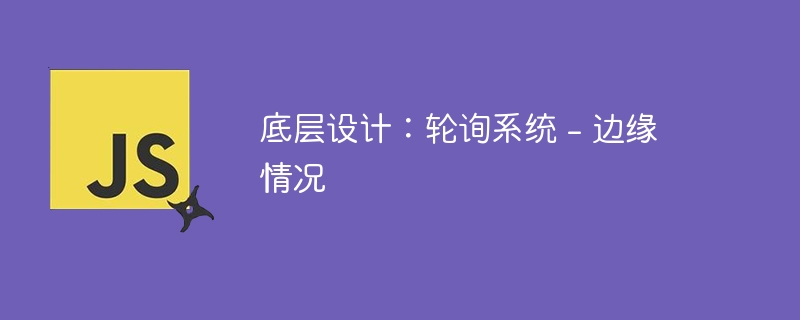
目录
案例 1 - 处理更新的版本控制
情况 2 - pollid 作为 uuid 而不是主键
情况 3 - 选项为空或无效
案例 4 - 重复选项
案例 5 - 问题长度限制
案例 6 - 投票过期
请先参考以下文章:
底层设计:投票系统:基本
-
底层设计:轮询系统 - 使用 node.js 和 sql
点击下载“C盘瘦身工具,一键清理C盘”;
边缘情况处理
案例1
要管理投票问题和选项的更新,同时保留与同一投票 id 关联的先前详细信息,您可以实现版本控制系统。这种方法允许您跟踪每次民意调查的历史数据,确保即使在更新后也保留旧的详细信息。
第 1 步:数据库架构更改
-
更新投票表
- 将 current_version_id 列添加到 polls 表中以跟踪投票的最新版本。
-
创建投票版本表
- 创建一个新表来存储民意调查的历史版本。
更新的数据库架构
create database polling_system;
use polling_system;
create table polls (
poll_id int auto_increment primary key,
current_version_id int,
created_at timestamp default current_timestamp,
foreign key (current_version_id) references poll_versions(version_id) on delete set null
);
create table poll_versions (
version_id int auto_increment primary key,
poll_id int,
question varchar(255) not null,
created_at timestamp default current_timestamp,
foreign key (poll_id) references polls(poll_id) on delete cascade
);
create table options (
option_id int auto_increment primary key,
poll_id int,
option_text varchar(255) not null,
foreign key (poll_id) references polls(poll_id) on delete cascade
);
create table votes (
vote_id int auto_increment primary key,
poll_id int,
user_id varchar(255) not null,
option_id int,
created_at timestamp default current_timestamp,
foreign key (poll_id) references polls(poll_id) on delete cascade,
foreign key (option_id) references options(option_id) on delete cascade
);
第 2 步:api 实施变更
更新轮询控制器
修改 updatepoll 方法,在创建新版本之前检查问题是否发生变化。
文件:controllers/pollcontroller.js
const pool = require('../db/db');
// create poll
exports.createpoll = async (req, res) => {
const { question, options } = req.body;
if (!question || !options || !array.isarray(options) || options.length {
return connection.execute(
'insert into options (poll_id, option_text) values (?, ?)',
[pollid, option]
);
});
await promise.all(optionqueries);
await connection.commit();
connection.release();
res.status(201).json({ pollid, message: "poll created successfully." });
} catch (error) {
console.error("error creating poll:", error.message);
res.status(500).json({ message: "error creating poll." });
}
};
// update poll
exports.updatepoll = async (req, res) => {
const { pollid } = req.params;
const { question, options } = req.body;
if (!pollid || !options || !array.isarray(options) || options.length {
return connection.execute(
'insert into options (poll_id, option_text) values (?, ?)',
[pollid, option]
);
});
await promise.all(optionqueries);
await connection.commit();
connection.release();
res.status(200).json({ message: "poll updated successfully." });
} catch (error) {
console.error("error updating poll:", error.message);
await connection.rollback();
res.status(500).json({ message: "error updating poll." });
}
};
// delete poll
exports.deletepoll = async (req, res) => {
const { pollid } = req.params;
try {
const connection = await pool.getconnection();
const [result] = await connection.execute(
'delete from polls where poll_id = ?',
[pollid]
);
connection.release();
if (result.affectedrows === 0) {
return res.status(404).json({ message: "poll not found." });
}
res.status(200).json({ message: "poll deleted successfully." });
} catch (error) {
console.error("error deleting poll:", error.message);
res.status(500).json({ message: "error deleting poll." });
}
};
// vote in poll
exports.voteinpoll = async (req, res) => {
const { pollid } = req.params;
const { userid, option } = req.body;
if (!userid || !option) {
return res.status(400).json({ message: "user id and option are required." });
}
try {
const connection = await pool.getconnection();
const [uservote] = await connection.execute(
'select * from votes where poll_id = ? and user_id = ?',
[pollid, userid]
);
if (uservote.length > 0) {
connection.release();
return res.status(400).json({ message: "user has already voted." });
}
const [optionresult] = await connection.execute(
'select option_id from options where poll_id = ? and option_text = ?',
[pollid, option]
);
if (optionresult.length === 0) {
connection.release();
return res.status(404).json({ message: "option not found." });
}
const optionid = optionresult[0].option_id;
await connection.execute(
'insert into votes (poll_id, user_id, option_id) values (?, ?, ?)',
[pollid, userid, optionid]
);
connection.release();
res.status(200).json({ message: "vote cast successfully." });
} catch (error) {
console.error("error casting vote:", error.message);
res.status(500).json({ message: "error casting vote." });
}
};
// view poll results
exports.viewpollresults = async (req, res) => {
const { pollid } = req.params;
try {
const connection = await pool.getconnection();
const [poll] = await connection.execute(
'select * from polls where poll_id = ?',
[pollid]
);
if (poll.length === 0) {
connection.release();
return res.status(404).json({ message: "poll not found." });
}
const [options] = await connection.execute(
'select option_text, count(votes.option_id) as vote_count from options ' +
'left join votes on options.option_id = votes.option_id ' +
'where options.poll_id = ? group by options.option_id',
[pollid]
);
connection.release();
res.status(200).json({
pollid: poll[0].poll_id,
question: poll[0].question,
results: options.reduce((acc, option) => {
acc[option.option_text] = option.vote_count;
return acc;
}, {})
});
} catch (error) {
console.error("error viewing poll results:", error.message);
res.status(500).json({ message: "error viewing poll results." });
}
};
第 3 步:更新投票路线
确保在 pollroutes.js 中正确定义路由。
文件:routes/pollroutes.js
const express = require('express');
const router = express.Router();
const pollController = require('../controllers/pollController');
// Routes
router.post('/polls', pollController.createPoll);
router.put('/polls/:pollId', pollController.updatePoll);
router.delete('/polls/:pollId', pollController.deletePoll);
router.post('/polls/:pollId/vote', pollController.voteInPoll);
router.get('/polls/:pollId/results', pollController.viewPollResults);
module.exports = router;
变更摘要
-
数据库:
- 更新了投票表以包含 current_version_id。
- 创建了 poll_versions 表来跟踪问题版本。
- 选项和投票表保持不变。
-
api:
- 创建了一个新的 createpoll 方法来初始化民意调查和版本。
- 更新了 updatepoll 方法以在创建新版本之前检查问题更改。
- 添加了投票和查看投票结果的方法。
-
路线:
- 确保定义所有必要的路由来处理民意调查创建、更新、投票和结果。
案例2
处理 pollid 需要是 uuid(通用唯一标识符)的场景。
以下是在轮询系统中为 thepollid 实现 uuid 的步骤,无需提供代码:
为投票 id 实施 uuid 的步骤
-
** 数据库架构更新:**
- 修改 polls、poll_versions、options 和 votes 表,以使用 char(36) 作为 poll_id 而不是整数。
- 创建一个新的 poll_versions 表来存储由 uuid 链接的投票问题和选项的历史版本。
-
** uuid 生成:**
- 决定生成uuid的方法。您可以使用应用程序环境中的库或内置函数来创建uuid。
-
** 创建投票逻辑:**
- 创建新投票时,生成一个 uuid 并将其用作 poll_id。
- 将新的投票记录插入投票表中。
- 将初始问题插入 poll_versions 表并将其与生成的 uuid 链接。
-
** 更新投票逻辑:**
- 更新投票时:
-
检查问题是否已更改。
- 如果问题已更改,请在poll_versions 表中创建一个新版本条目来存储旧问题和选项。
- 根据需要使用新问题和选项更新投票表。
-
** 投票逻辑:**
- 更新投票机制,确保使用uuid作为poll_id。
验证投票请求中提供的 uuid 是否存在于 polls 表中。
-
** api 更新:**
- 修改 api 端点以接受并返回 poll_id 的 uuid。
- 确保所有 api 操作(创建、更新、删除、投票)一致引用 uuid 格式。
-
** 测试:**
- 彻底测试应用程序,确保在所有场景(创建、更新、投票和检索投票结果)中正确处理 uuid。
-
** 文档:**
- 更新您的 api 文档以反映 poll_id 格式的更改以及与版本控制和 uuid 使用相关的任何新行为。
按照以下步骤,您可以在轮询系统中成功实现 pollid 的 uuid,同时确保数据完整性和历史跟踪。
案例3
空或无效选项
验证方法:
- api 输入验证: 在 api 端点中实施检查,以验证请求正文中提供的选项不为空并满足特定条件(例如,如果不允许,则不得使用特殊字符)。
- 反馈机制:如果选项无效或为空,向用户提供清晰的错误消息,指导他们纠正输入。
案例4
重复选项
唯一性检查:
- 预插入验证: 在将选项添加到投票之前,检查数据库中现有选项是否有重复项。这可以通过使用轮询 id 查询选项表并将其与新选项进行比较来完成。
- 用户反馈:如果检测到重复选项,则返回一条有意义的错误消息,通知用户哪些选项是重复的,从而允许他们相应地修改其输入。
案例5
问题长度限制
字符限制:
- api 验证: 设置 api 中投票问题和选项的最大字符限制。这可以通过在创建和更新过程中检查问题的长度和每个选项来完成。
- 用户界面反馈:实施客户端验证,以便在用户输入时超出字符限制时向用户提供即时反馈,增强用户体验。
案例6
投票过期
过期机制:
- 时间戳管理: 将时间戳字段添加到投票表中,以记录每个投票的创建时间,还可以选择另一个字段来记录到期日期。
- 计划检查: 实施后台作业或 cron 任务,定期检查过期的轮询并将其在数据库中标记为非活动状态。这还可以包括阻止对过期民意调查进行投票。
- 用户通知:(可选)通知投票创建者和参与者即将到期的日期,以便他们在投票变为非活动状态之前参与投票。
请先参考以下文章:
底层设计:投票系统:基本
-
底层设计:轮询系统 - 使用 node.js 和 sql
点击下载“C盘瘦身工具,一键清理C盘”;
更多详情:
获取所有与系统设计相关的文章
标签:systemdesignwithzeeshanali
系统设计与zeeshanali
git:https://github.com/zeeshanali-0704/systemdesignwithzeeshanali



